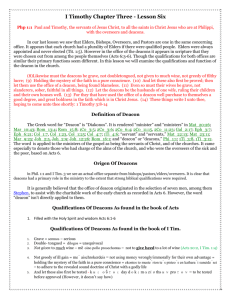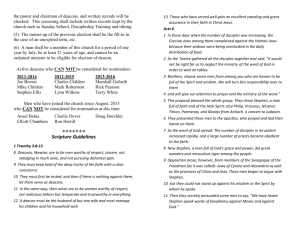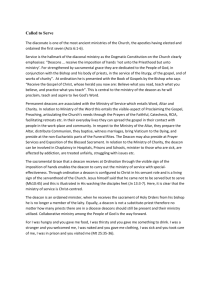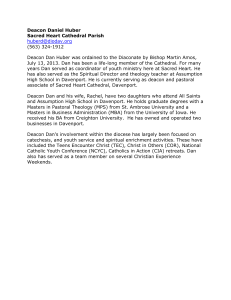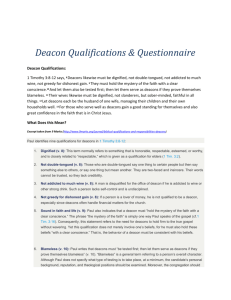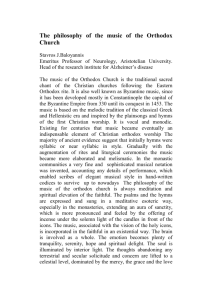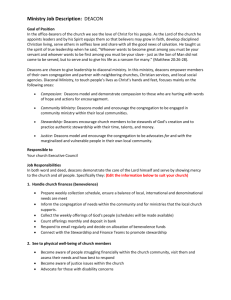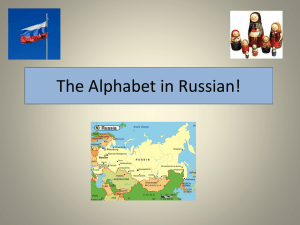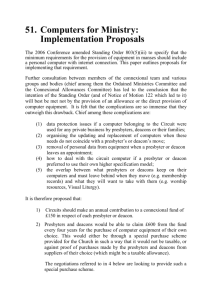History of the Russian Orthodox Church The Russian Orthodox
advertisement
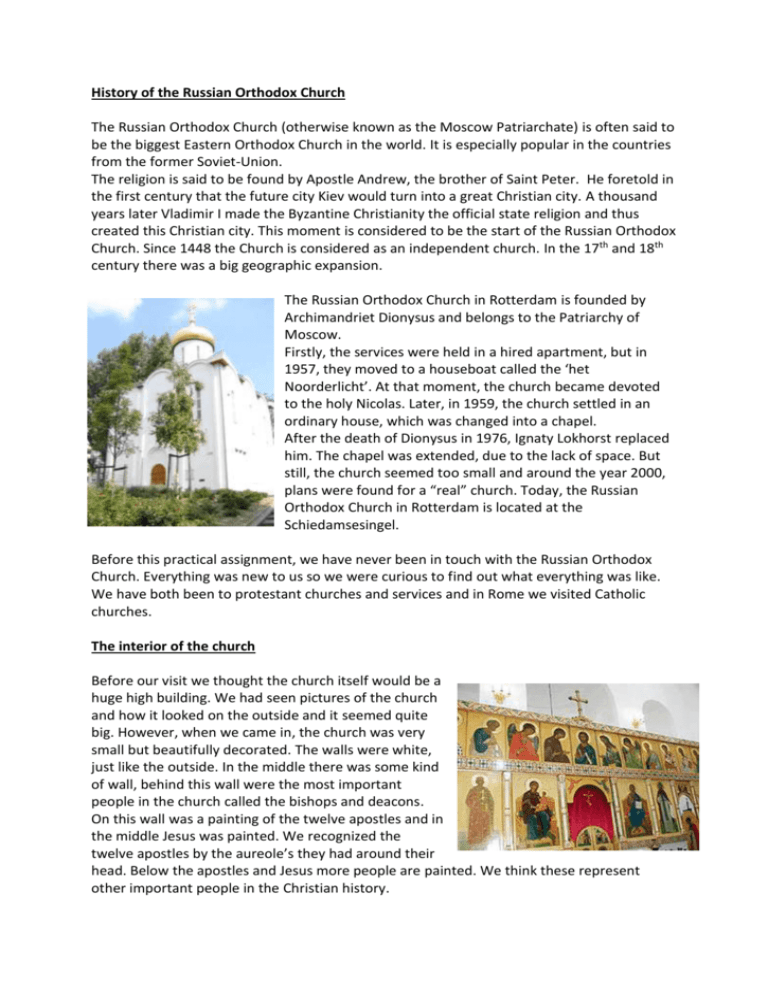
History of the Russian Orthodox Church The Russian Orthodox Church (otherwise known as the Moscow Patriarchate) is often said to be the biggest Eastern Orthodox Church in the world. It is especially popular in the countries from the former Soviet-Union. The religion is said to be found by Apostle Andrew, the brother of Saint Peter. He foretold in the first century that the future city Kiev would turn into a great Christian city. A thousand years later Vladimir I made the Byzantine Christianity the official state religion and thus created this Christian city. This moment is considered to be the start of the Russian Orthodox Church. Since 1448 the Church is considered as an independent church. In the 17th and 18th century there was a big geographic expansion. The Russian Orthodox Church in Rotterdam is founded by Archimandriet Dionysus and belongs to the Patriarchy of Moscow. Firstly, the services were held in a hired apartment, but in 1957, they moved to a houseboat called the ‘het Noorderlicht’. At that moment, the church became devoted to the holy Nicolas. Later, in 1959, the church settled in an ordinary house, which was changed into a chapel. After the death of Dionysus in 1976, Ignaty Lokhorst replaced him. The chapel was extended, due to the lack of space. But still, the church seemed too small and around the year 2000, plans were found for a “real” church. Today, the Russian Orthodox Church in Rotterdam is located at the Schiedamsesingel. Before this practical assignment, we have never been in touch with the Russian Orthodox Church. Everything was new to us so we were curious to find out what everything was like. We have both been to protestant churches and services and in Rome we visited Catholic churches. The interior of the church Before our visit we thought the church itself would be a huge high building. We had seen pictures of the church and how it looked on the outside and it seemed quite big. However, when we came in, the church was very small but beautifully decorated. The walls were white, just like the outside. In the middle there was some kind of wall, behind this wall were the most important people in the church called the bishops and deacons. On this wall was a painting of the twelve apostles and in the middle Jesus was painted. We recognized the twelve apostles by the aureole’s they had around their head. Below the apostles and Jesus more people are painted. We think these represent other important people in the Christian history. As you can see on the picture, there are four doors in the wall. Two are in the middle and there is one on each side. Behind the wall were the bishops who came through the doors during the service so they could say their prayers. On the walls were a lot of beautiful paintings; all painted in the same style as the middle wall. On these paintings other important people in Christian history were illustrated. Below the paintings there were a lot of small candles. The believers bought these small candles at a small desk and they lit them. In the middle of the building there was a beautiful small carpet. On it stood a painting of a saint. Most people present in the church came to this painting to kiss it. This was something I’d never seen anyone do. We weren’t able to take a close look at what was behind the wall, but when the doors opened (which they did a few times) we could see that there was a large gold altar. The service When we entered the building a lady whispered to us that it was a special service today. We were told that the service would start at 6:30 pm, but when we entered around 6:15 pm the bishop had already started to bless the people individually. After this, the service started and the deacons went behind the wall. During the service, prayers were sung. I noticed that the ‘normal’ people didn’t sing or talk during the service. Only the deacons and the choir talked/sung. It was a pity that we couldn’t understand what the deacon said because he talked in Church Slavonic or modern Russian. Only two or three small parts were in Dutch. However, the service was beautiful. The deacons would come from behind the wall, stand with their backs to the rest of the people and say their prayers. The way the deacons said the prayers was special to us, as they almost sung them. After they ‘sung’ a sentence, the choir would sing a small part, then the deacon would say something again and this would continue. We also had to kneel a few times. Also, they drew a cross many time. We found this very interesting as it’s not very common to do this in a protestant church. There was one moment in the service which made a very big impression on us. All the attendees went to the deacon to get their blessing, and they took a sip of wine and a little piece of bread. We decided not to go to the deacon and to not take the wine and bread, as we thought it would be disrespectful because it doesn’t have as much of a meaning to us. A woman who had been sitting on the stairs for the whole service because she wasn’t able to stand for a long time (and she could barely walk) also went to the deacon and the bread. After that she walked to us and also gave the small pieces of bread to us. This made us feel very special and appreciated. To us it was the most special and most touching part of the service. We thought it was a beautiful gesture of her. When the service ended we asked the lady why this service was so special, and she told us that that one of the deacons would explain it to us because her Dutch wasn’t good enough to explain. When the deacon came she asked him if he would explain us. The deacon was a very friendly man and started explaining us that it had to do with Easter. As the Russian Orthodox Church uses the Julian calendar instead of the Gregorian calendar that we use, Easter falls on a different time. It was a special service because a period of fasting had just started. He also told us that the service we experienced was considered a short service. We were surprised because it already lasted for one and a half hours! He also said that there were weekend services. On Saturday there would be a service and on Sunday there would be a special service again for Easter. When the deacon asked if we had other questions, we asked him about the candles. Below the paintings on the wall were a lot of small candles. We noticed that the attendees kept an eye on those candles, and whenever their light was almost out they picked them up, blew them out and threw them away. We wanted to know why those candles were so special and what they meant to him and/or the attendees. The deacon kindly answered our question, telling us that the attendees could light a candle for different reasons. A few reasons might be: lighting a candle for someone who passed away to show that you remember them, as way of praying, to thank God for something, or for an important man/woman in Christian history, for example if this person means a lot to you. We weren’t able to ask someone more questions as most people had already left the church when we had finished talking to the deacon. The atmosphere in the church was very special to us. We thought the people would look or stare at us, but none of that happened. Everyone looked very friendly and respected us for being there. What we thought was special in the behaviour of the attendees was that the men and women stood separated. The women stood on the left and the men on the right. This shows a difference in the treatment of men and women. But everyone in church had the same value, so men weren’t ‘better’ than women. We couldn’t notice other differences. There is not a lot of extra attention to youth in the community. On the site stood that there are camps for youth, but that was in 2009. There were some children present at the service but those were 3 to 10 years old. They were walking through the church the entire time but nobody seemed to mind. One boy however was with the deacons the entire time. He also said prayers. We didn’t ask him, but we think he was doing some kind of First Communion. We thought it was a pity that the service was in Church Slavonic and modern Russian because we couldn’t understand what the prayers were about. But because the rest of the attendees talked at least modern Russian and maybe Church Slavonic, they were able to understand. Another negative point was that we had to stand for the whole one and a half hours. This was very tiring. We were surprised when the deacon said this was considered a short service! However, there were a lot of positive points too. One of them being the kindness of everyone towards us. They didn’t stare at us for being there or acted weird towards us. They gave us a very friendly impression and the deacon was more than ready to answer our questions if we had them. Another positive point is that there wasn’t one boring moment in the service. Sometimes it was tiring but it was never boring. We especially liked how the deacons ‘sung’ everything and how they combined this with the singing of the choir. It was done in a beautiful way. We must admit that we were nervous before going into the church. We have had emailcontact and were told that we had to wear a skirt and something on our head. Because of this we thought everything would be very strict, also because it’s an orthodox church. We also thought it would be hard to have our questions answered, but as said before: the deacon was a very friendly person and everyone else made a very friendly impression too. We are happy that we went to the Russian Orthodox Church, while we learned a lot!
